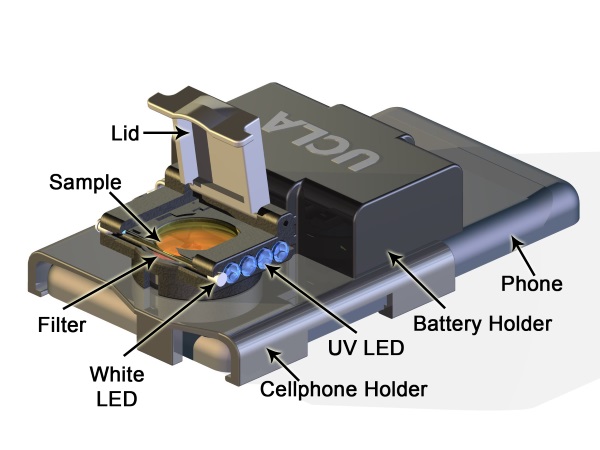Cellphone-based detection platform for rbST biomarker analysis in milk extracts using a microsphere fluorescence immunoassay published in Analytical Chemistry (2014)
S.K.J. Ludwig , H. Zhu ,

Current contaminant and residue monitoring throughout the food chain is based on sampling, transport, administration, and analysis in specialized control laboratories. This is a highly inefficient and costly process since typically more than 99 % of the samples are found to be compliant. On-site simplified prescreening may provide a scenario in which only samples that are suspect are transported and further processed. Such a prescreening can be performed using a small attachment on a cellphone. To this end, a cellphone-based imaging platform for a microsphere fluorescence immunoassay that detects the presence of anti-recombinant bovine somatotropin (rbST) antibodies in milk extracts was developed. RbST administration to cows increases their milk production, but is illegal in the EU and a public health concern in the USA. The cellphone monitors the presence of anti-rbST antibodies (rbST biomarker), which are endogenously produced upon administration of rbST and excreted in milk. The rbST biomarker present in milk extracts was captured by rbST covalently coupled to paramagnetic microspheres and labeled by quantum dot (QD)-coupled detection antibodies. The emitted fluorescence light from these captured QDs was then imaged using the cellphone camera. Additionally, a dark-field image was taken in which all microspheres present were visible. The fluorescence and dark-field microimages were analyzed using a custom-developed Android application running on the same cellphone. With this setup, the microsphere fluorescence immunoassay and cellphone-based detection were successfully applied to milk sample extracts from rbST-treated and untreated cows. An 80 % true-positive rate and 95 % true-negative rate were achieved using this setup. Next, the cellphone-based detection platform was benchmarked against a newly developed planar imaging array alternative and found to be equally performing versus the much more sophisticated alternative. Using cellphone-based on-site analysis in future residue monitoring can limit the number of samples for laboratory analysis already at an early stage. Therewith, the entire monitoring process can become much more efficient and economical.